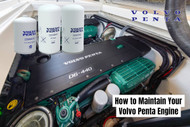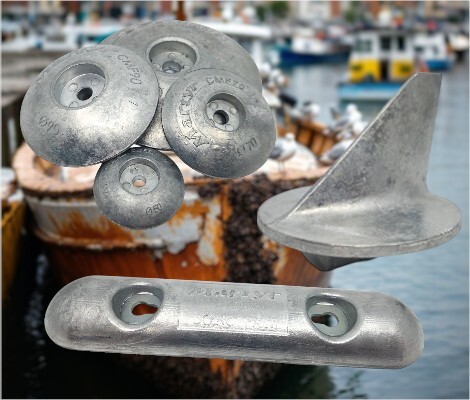How to Maintain Your Volvo Penta Engine: Essential Parts & DIY Tips
7th Jul 2025
Your Volvo Penta engine is the heart of your vessel—keeping it well-maintained ensures safety, reliability, and longevity out on the water. Whether you’re a weekend sailor, a fishing enthusiast, or enjoy longer voyages, neglecting routine maintenance can lead to costly breakdowns. This guide is tailored exactly for boaters like you who want to perform smart DIY maintenance and know when to let the pros take over. From oil filters to sail‑drive zinc anodes, we’ll walk through each critical component, helping you protect your investment, tighten performance, and boost your boating experience.
Regular Oil & Filter Changes
Why it matters: Clean oil prevents friction, heat buildup, and wear. Volvo Penta engines—such as the 3.0, D-series, and MD series—should have their oil and oil filters changed every 100 hours or at least annually, whichever comes first.
DIY checklist:
- Start the engine for a few minutes to warm the oil.
- Use an extractor pump like our Pela P-650 to suck oil out or remove the drain plug to drain old oil.
- Replace with a genuine Volvo Penta oil filter, like the 861476, for Volvo Penta models
- Refill with OEM-recommended oil, e.g., VDS‑4.5 SAE 15W‑40.
- Check for leaks, run the engine, and recheck the oil level.
Pro tip: Keep a maintenance log noting date, hours, filter part, and oil type. This simple record gives visibility into your engine’s history and helps prevent missed services.
Sail‑Drive Zinc Anode Care
Why it matters: Sail-drive zinc anodes protect your underwater gear from galvanic corrosion in saltwater environments. Wear them down, and you're risking serious damage to crucial parts.
What to check:
- Inspect the anode—replace it when it’s half-worn.
- For Volvo Penta, common parts include the 22651246 (SD130/SD150 sail-drive) or 823661 zinc anode.
- Torque per manufacturer specs and replace the sail-drive oil at regular intervals.
DIY tip: Rotate anode removal by hand (with gear disengaged and boat out of water), re-torque to spec, and top up sail-drive oil. Clean the drive housing before installing the new anode.
Cooling System Maintenance – Impellers & Raw Water Pump
Why it matters: Without fresh water flow, engines overheat. Impeller failure can happen quickly and silently.
Step-by-step:
- Shut the seacock and remove the pump cover when the engine is off.
- Extract old impeller—replace annually or every 200 hrs.
- Lightly grease the vanes on the new one for easy insertion.
- Reinstall cover, re-open seacock, and test water flow.
✅ Pro tip: Carry a spare impeller onboard—a critical item for unexpected failures at sea.
Fuel & Air Filter Maintenance
Why it matters: Clean fuel and air are essential to smooth engine operation. Dirty filters reduce power, cause smoke, and may stall your engine.
Routine:
- Change fuel filters every 100 hrs or annually—check for water, debris, and use quality OEM parts.
- Replace air filters on schedule or yearly.
- After installation, run the engine and check for leaks.
Pro tip: Keep spare filters in your parts bin—great for remote maintenance or emergency replacements.
Belts, Hoses & Fuel Lines
Perform visual and manual checks for cracks, wear, and tension on belts and hoses. Tighten per specs. Stop anytime it looks brittle or damaged. Inspect fuel hoses and clamps yearly and replace them when unsure. Catching small problems prevents big breakdowns.
Reversing Gear & Transmission Fluids
Volvo Penta’s reversing gear/transmission should be serviced every season or 200 to 250 hours:
- Drain and replace gear oil with Genuine Volvo Penta IPS oil.
- Inspect gearbox seals and linkages.
- For sterndrives or IPS units, double-check cooler components and ensure no oil leaks.
Winterisation & Long-Term Storage
If your boat is out of the water during off-season:
- Change oil, filters, and impeller before storing.
- Flush cooling systems with fresh water and drain proper systems to avoid freezing damage.
- Add fuel stabiliser, disconnect battery, and follow your engine’s long‑term storage procedures.
Knowing When to Call a Pro
DIY can cover a lot, but here are warning signs you shouldn't ignore:
- Overheating
- High hours (over 250 hrs or annually)
- Noticeable oil/gear oil leaks
- Unusual vibrations, smoke, or noises
At this point, book a certified Volvo Penta marine mechanic to inspect hoses, belts, pump seals, and perhaps perform compression checks.
Wrap-up & Next Steps
Performing routine maintenance on your Volvo Penta isn’t just about ticking off a checklist—it supports engine reliability, reduces running costs, and helps ensure safety while boating. By sticking to these tasks—oil/filters, zinc anodes, impellers, belts, and fluids—you’ll be helping your engine thrive for years.
Have a question about your Volvo Penta engine, or want help selecting parts? Contact our marine experts or explore our DIY Maintenance Kits designed for your exact engine model. For advanced issues, our certified technicians are here to keep your miles smooth and worry-free.

 Australian Dollars
Australian Dollars


